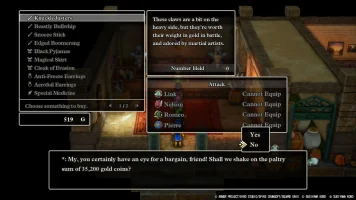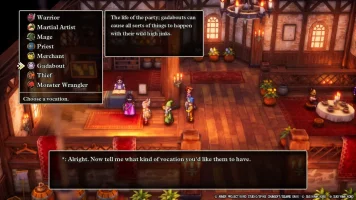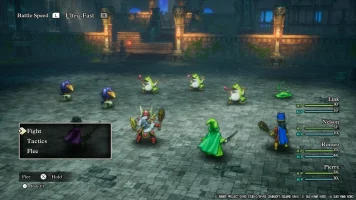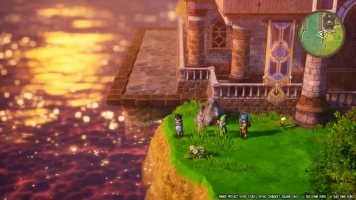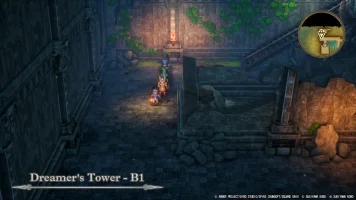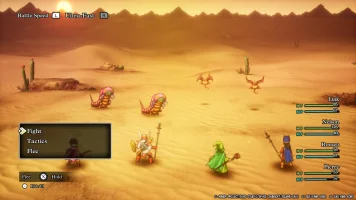Official Review
Several years back, Square Enix made waves by announcing a remake of Dragon Quest III using their acclaimed HD-2D engine, followed by an extended period of silence that left fans wondering about its progress. The development team then made the ambitious decision to remake Dragon Quest I and II as well. Now that Dragon Quest III HD-2D Remake has finally arrived, we can confidently say that the extended wait has proven worthwhile. Despite some minor shortcomings, this version stands as the most comprehensive and entertaining iteration of Dragon Quest III to date.
Originally launching in Japan in 1988, Dragon Quest III emerged from an era of gaming simplicity, resulting in a narrative that's notably more straightforward than modern RPG offerings. Players step into the shoes of an unnamed warrior, offspring of a renowned hero, tasked with following in their father's footsteps to defend the world from an ominous dark lord. The story lacks complex character development or narrative intricacy—your protagonist serves as a blank canvas, while party members function essentially as animated figures with basic statistics and equipment. Although the game introduces clever connections to other series entries and new cinematics exploring your father's journey, the core plot remains fundamentally straightforward: defeat the evil threatening the world.
While those seeking sophisticated RPG narratives might find themselves disappointed, Dragon Quest III's storytelling isn't without its unique appeal. What the plot lacks in complexity, it abundantly compensates for with its distinctive charm, primarily evident in its presentation style. For instance, rather than encountering generic enemy names like 'Giant Enemy Crab' during random battles, you'll face whimsically named foes such as "Crabber dabber doo." Even in distant towns across the continent, NPCs interact with a familiar warmth, treating you like a longtime resident rather than a stranger. Despite its narrative simplicity, the game's engaging approach creates an irresistibly welcoming atmosphere that draws players deeper into its world, encouraging exploration of its hidden mysteries.
As the franchise that essentially established the foundational template for JRPGs—a format that has influenced the genre for decades—Dragon Quest III showcases these classic elements in their purest form. The gameplay loop involves gathering a party to traverse an expansive overworld, visiting towns to replenish supplies and rest, delving into dungeons for extended expeditions typically culminating in boss encounters, and repeating this pattern across different locations.
For seasoned RPG players, the game's structure will feel familiar, yet this tried-and-tested formula persists for good reason. The journey of battling enemies, acquiring better equipment, and conquering increasingly challenging dungeons creates an immensely satisfying progression curve. Your team's growth under your leadership, especially when overcoming seemingly insurmountable challenges, delivers a profound sense of achievement. The game masterfully maintains tension by keeping you slightly underpowered for each new challenge, while occasional returns to earlier areas serve as powerful reminders of your team's remarkable progress as you effortlessly dispatch once-formidable foes.
Character progression combines a conventional leveling system with an elegantly streamlined class mechanic, offering enough flexibility to customize your team without overshadowing the core gameplay loop of exploration and combat. The game provides access to approximately twelve distinct classes for recruitment (though party size remains limited to four), and later introduces a reclassing option. This feature allows characters to learn diverse combat abilities at the cost of temporarily reduced levels and statistics. These options, combined with opportunities to farm Metal Slimes for rapid advancement, create numerous paths for party development, enhancing replay value for those interested in multiple playthroughs after completing the main story.
The combat system features traditional turn-based battles triggered through random encounters, offering both manual control and automated options. Players can either direct each character's actions individually or assign preset behavioral patterns such as "prioritize healing" or "attack aggressively." The artificial intelligence performs admirably in executing these instructions, making routine battles more manageable, while the option to assume manual control for challenging encounters remains readily accessible. The only minor criticism of the combat system involves an unavoidable first-person perspective shift during action animations, despite the presence of detailed battle sprites visible during command selection.
While maintaining the essence of the original release, Square has implemented various enhancements and quality-of-life improvements to align with contemporary series standards. The game incorporates features from later installments, such as an enhanced Monster Arena and the introduction of the Monster Wrangler class, enriching the overall experience. Modern additions like battle speed adjustment options and clear objective markers on the map help streamline gameplay without compromising the original's core appeal. Though purists might question these changes, this version represents the definitive Dragon Quest III experience—thoughtfully modernized for contemporary audiences while preserving the fundamental elements that made the original a classic.
Despite these modern enhancements, it's important to acknowledge that this remake builds upon the foundation of a late 1980s Famicom title. While it offers a pure, classic JRPG experience, its mechanics may feel basic when compared to contemporary RPGs or even its own successor, Dragon Quest XI. This isn't necessarily a criticism, but players accustomed to complex skill trees, diverse minigames, and intricate crafting systems might find Dragon Quest III's core gameplay loop relatively straightforward.
However, the most striking transformation comes from the implementation of HD-2D graphics, which breathes new life into this classic adventure. The visual overhaul features meticulously detailed hi-bit character and enemy sprites, complemented by fully realized 3D environments enhanced with modern lighting effects. This technological advancement brings unprecedented vitality to the game world, making it feel more immersive than any previous version. Square's HD-2D engine once again demonstrates its ability to seamlessly blend retro aesthetics with contemporary visual elements, creating an experience that truly must be witnessed firsthand on the Switch to appreciate its unique charm.
Unfortunately, these visual improvements come with some technical compromises. The Switch hardware notably struggles to maintain consistent performance, with noticeable frame rate fluctuations occurring in most populated areas. While these performance issues don't significantly impact the turn-based gameplay, which doesn't require quick reflexes, they remain a disappointing aspect of an otherwise polished remake. Given Square Enix's six years of experience with HD-2D technology and the smooth performance of previous titles using this engine, these technical limitations are particularly puzzling. Though not game-breaking, these performance issues somewhat tarnish an otherwise exemplary remake.
The audio experience, however, provides a perfect counterbalance to these technical shortcomings. The soundtrack masterfully establishes a warm, inviting atmosphere through its diverse symphonic arrangements. From the jazzy ambiance of the Monster Arena to the gentle, nocturnal melodies of village themes, the musical score demonstrates remarkable range while maintaining exceptional quality throughout. Even in the most treacherous dungeons, the signature Dragon Quest charm permeates the musical composition, creating a cohesive audio experience that enhances every location and situation in the game.
Conclusion
After weighing all aspects of this remarkable remake, it's gratifying to report that Dragon Quest III HD-2D Remake largely fulfills its ambitious promises. While the aforementioned performance issues do cast a slight shadow, this reimagining stands as a faithful tribute to a beloved RPG classic, successfully amplifying its core strengths while thoughtfully addressing its historical limitations. The game's straightforward approach might not appeal to everyone, but there's something refreshingly focused about its design philosophy – it delivers a complete experience without falling into the common trap of feature bloat or unnecessary complexity.


